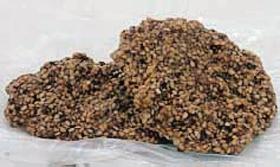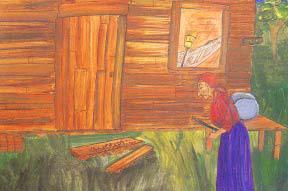|
|  Wangla
Of the many candies they offer, one of
the most popular in demand is the
“sesame seed candy,” or better known
in Creole and Spanish as “wangla
seed” and “jojoli”. But how is it made
and what makes it so popular? According
to Elvira Peralta, owner, the candy
is very easy to make, “it is for people
who have a sweet tooth or want to try
something different.” The process of
making the candies is simple; “first,
get yourself some sesame seeds from
your local stores, add sugar in a bowl
with a little oil and water. Keep stirring
the syrupy contents until thick in
texture. Then, take it out using a
wooden spoon and pour on top of wrapping
paper and let it cool,” added
Monteros. The taste is exquisite and it
is sure to leave you coming back on a
regular basis. If you get lucky, you will
run into someone selling “wangla,” and
if you still do not know what it is, think
of a thin peanut brittle made with thousands
of sesame seeds. Truly a sweet
tooth craver, try it today!
The following is a story of the OLE HEG, (Old Hag) who is associated closely with Sesame/Wangla Seeds. Belizean folklores are heavy with hidden meaning, and this one is no exception.
“Skinny, skinny, yu no know me?” This is a tortured cry of the vampirelike OLE HEG*, popularly depicted as an old woman in stories told throughout rural Belize. Loggers at our old mahogany camps told about her and she is believed to have African roots but also resembles the witches or brujas of Maya lore. Belizean poet James Sullivan Martinez, who spent much of his youthful years with his father at logging camps, was inspired to write about her in a local newspaper. OLE HEG is said to frequent communities with dilapidated buildings, emerging late at night, in search of victims from whom she can suck blood. She prepares for her attack by uttering an oracion or prayer that will allow her to remove her skin, which she hangs on a ceiba tree or places in a mortar (these were kept in the outdoor cooking area in the earlier days). It is said that she will then transform herself into a flying ball of fire and dwindle to a minute ray of light that can enter a home through the keyhole. Some say that she straps two straw mats to her arms in order to fly on to the thatched roof of a house and sits there, peeking in until the moment for her entrance is right. Once inside, she chooses any sleeping person, although children are her favorite victims. She visits on several successive nights, sucking blood from the same person. Her victims become paler and thinner each day and often die as a result. OLE HEGS are numerous and perhaps the only folklore characters who train others to adopt their behavior. In the training, the experienced OLE HEG hoists the novice into the air and recites incantations that cause them both to rise higher and higher in the skies. The novice receives one specific instruction – not to say “Oh Lord” at any time while in the air. These words are believed to counter the effect of the evil forces at work among OLE HEGS. Although Ole Heg is usually portrayed as an old woman, belief in the “training” process may be what has prompted stories which describe her as a teenage girl or a middle-aged woman. As powerful as she is, Ole Heg is unlikely to venture out during the day. Children who are not aware of this will still tease old women and mark bridges, doors, and windows with chalk in an attempt to keep Ole Heg away. Ole Heg can be kept at bay in several ways, one of the easiest being to dress in blue, a color she avoids. At night parents often put their children to sleep in a blue garment, as protection from her. Another of Ole Heg’s enemies is asafoetida, a foul-smelling gum resin that will keep her far away. An up-side down broom will also prevent her from coming into the house. It is common for people to scatter wangla (sesame) seeds on the floor in their homes or on their doorsteps, because, on seeing the seeds, OLE HEG becomes obsessed with picking them up (see illustration). She does this slowly, one by one, and when her hand is full, she pours them on the ground and begins to collect them again, over and over until morning comes. She cannot leave until night falls again, and once OLE HEG has been trapped in this way, she can be beaten to death with a broom. Perhaps because of her association with these seeds she is called Wangla Lady.
Click here to return to the main page for Sweet Treats
|



